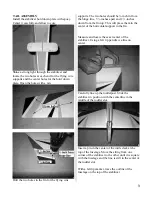
If the removable stabilizer option is used cover the
top of the stabilizer with wax paper before
proceeding.
With the wax paper still in place coat the inside of
the rudder slot with epoxy and slide the rudder
forward until the rudder post is against the back of
the fuselage with the post pins engaged. Allow to
cure.
Install the two stabilizer lock down screws with
knurled nuts. Bend the flying wire mounts to 45-
degrees and install as shown.
Install the flying wire bracket on the fuselage
bottom. The bracket should be 5 ½-inches forward
fr
om the fuselage back edge. Install the lower flying
wires. Use the knurled nuts to lock the
cle
vises in place. The flying wires are adjusted so all
endplay is gone, but not tight enough to flex the
stabilizer.
5

































